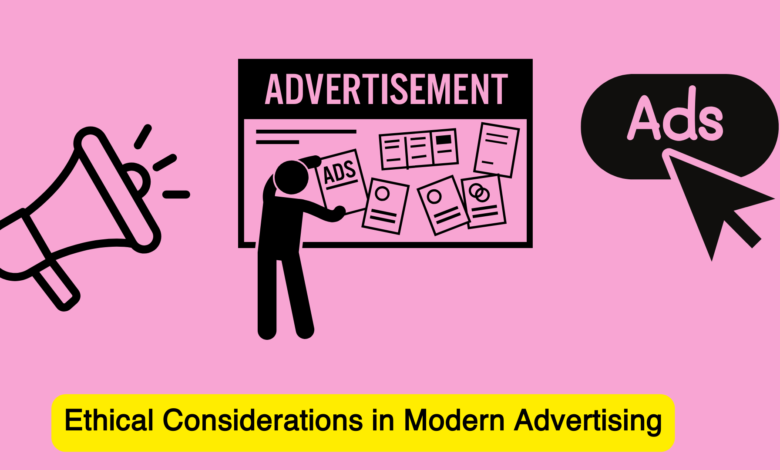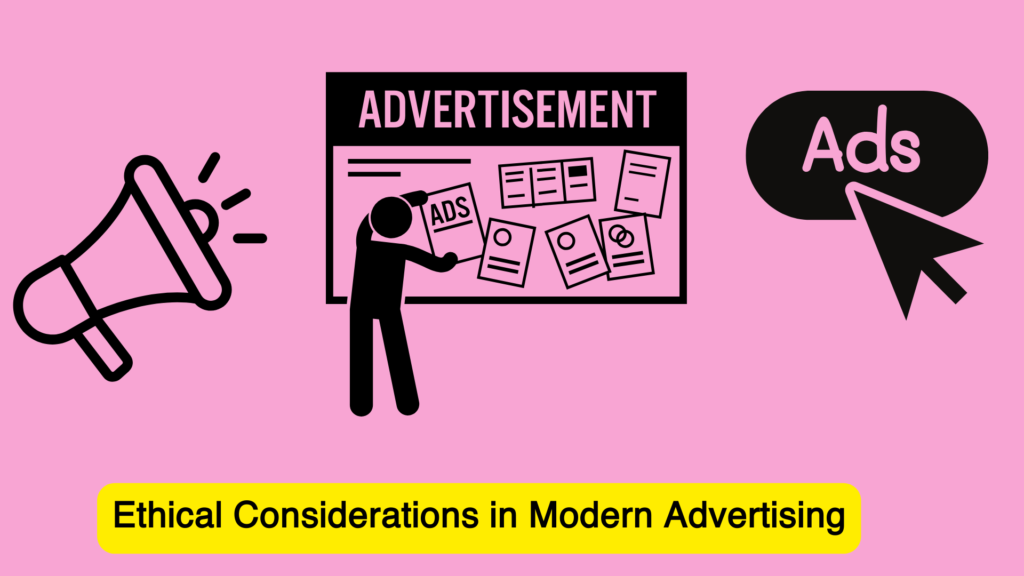Innovative Strategies and Ethical Considerations in Modern Advertising

The advertising landscape has evolved dramatically over the past few decades, driven by advancements in technology and changes in consumer behavior. Modern advertising goes beyond traditional methods, embracing digital innovations and data-driven strategies to reach and engage audiences. However, with these advancements come new ethical considerations and challenges. This article explores innovative advertising strategies, the role of technology, and the ethical implications that businesses must navigate to build trust and maintain a positive brand image.

The Role of Technology in Modern Advertising
- Digital Transformation
The digital revolution has transformed advertising, providing brands with new platforms and tools to connect with consumers. The internet, social media, and mobile devices have created a dynamic and interactive environment where brands can engage with audiences in real-time. Digital advertising encompasses a wide range of formats, including display ads, video ads, social media ads, and influencer partnerships. The ability to track and analyze data has also enabled more precise targeting and measurement of campaign effectiveness.
- Artificial Intelligence and Machine Learning
Artificial intelligence (AI) and machine learning (ML) have revolutionized advertising by enabling sophisticated data analysis and automation. AI algorithms can process vast amounts of data to identify patterns, predict consumer behavior, and optimize ad placements. Machine learning models continuously improve over time, allowing for more accurate targeting and personalized content delivery. AI-powered chatbots and virtual assistants also enhance customer interactions, providing personalized recommendations and support.
- Programmatic Advertising
Programmatic advertising automates the buying and selling of ad space through real-time bidding (RTB). This technology uses algorithms to analyze user data and deliver ads to the right audience at the right time. Programmatic advertising increases efficiency, reduces costs, and allows for precise targeting. It also provides advertisers with real-time analytics, enabling them to optimize campaigns and improve performance. Programmatic advertising has become a standard practice in digital marketing, driving a significant portion of online ad spending.
- Augmented Reality (AR) and Virtual Reality (VR)
AR and VR technologies are creating immersive and interactive advertising experiences. Augmented reality overlays digital content onto the real world, allowing users to interact with products in a virtual environment. For example, AR apps enable customers to visualize how furniture will look in their homes or how clothing will fit. Virtual reality offers fully immersive experiences, transporting users to virtual environments where they can explore products and brand stories. These technologies enhance engagement and provide unique brand experiences.
- Voice Search and Smart Speakers
The rise of voice-activated devices like Amazon Echo, Google Home, and Apple’s Siri has introduced new opportunities for voice search advertising. Voice search queries tend to be conversational and longer than text-based searches. Advertisers need to optimize their content for voice search by using natural language and answering common questions. Voice search advertising can also include sponsored voice responses and branded skills or actions on smart speakers.
Innovative Advertising Strategies
- Personalization and Hyper-Targeting
Personalization is a key trend in modern advertising. Consumers expect relevant and personalized experiences that cater to their interests and preferences. Personalization involves using data to create customized messages, offers, and recommendations. Hyper-targeting goes a step further by delivering ads based on specific behaviors, demographics, and psychographics. This level of targeting increases the relevance of ads, improves engagement, and enhances the customer experience.
- Content Marketing and Storytelling
Content marketing focuses on creating valuable and relevant content to attract and engage audiences. It goes beyond traditional advertising by providing informative, entertaining, or inspirational content that resonates with consumers. Storytelling is a powerful technique within content marketing, as it helps brands connect with audiences on an emotional level. By sharing authentic stories, brands can build trust, create a sense of community, and foster brand loyalty.
- Influencer Marketing
Influencer marketing leverages individuals with a significant following on social media or other online platforms to promote products. Influencers act as brand ambassadors, sharing their experiences and endorsements. This form of advertising can be highly effective due to the trust and credibility influencers have with their followers. Brands can collaborate with influencers on sponsored posts, product reviews, unboxing videos, and more. Micro-influencers, who have smaller but highly engaged audiences, are also gaining popularity for their authenticity and niche expertise.
- Native Advertising
Native advertising involves placing ads that match the look and feel of the platform on which they appear. Unlike traditional banner ads, native ads blend seamlessly with the content, making them less intrusive and more engaging. Native ads can take the form of sponsored articles, in-feed ads, or promoted listings. This format is particularly effective for content-driven platforms, as it provides value to the audience while promoting the brand.
- Experiential Marketing
Experiential marketing focuses on creating memorable experiences that engage consumers and foster emotional connections. It involves live events, pop-up stores, product demonstrations, and immersive installations. Experiential marketing allows consumers to interact with the brand in a physical or virtual space, creating lasting impressions and driving word-of-mouth. This strategy is particularly effective for launching new products, building brand awareness, and creating buzz.
Ethical Considerations in Advertising
- Transparency and Honesty
Transparency and honesty are fundamental principles of ethical advertising. Consumers expect brands to be truthful about their products and services. Misleading or deceptive ads can harm consumers, damage a brand’s reputation, and lead to legal consequences. Advertisers must ensure that their claims are accurate and verifiable. Clear disclosure of sponsored content and partnerships is also essential to maintain transparency.
- Privacy and Data Protection
The collection and use of consumer data raise significant privacy concerns. Advertisers must comply with data protection regulations, such as the General Data Protection Regulation (GDPR) in the European Union and the California Consumer Privacy Act (CCPA) in the United States. Brands should obtain explicit consent from consumers before collecting personal data and provide clear information about how the data will be used. Protecting consumer data from breaches and misuse is crucial for maintaining trust and credibility.
- Social Responsibility
Social responsibility in advertising involves promoting ethical values and positive messages. Brands have a responsibility to consider the impact of their ads on society, including the portrayal of gender, race, and other social issues. Advertising that perpetuates stereotypes or promotes harmful behaviors can have negative consequences. Brands should strive to create inclusive and respectful ads that reflect diversity and promote positive social change.
- Targeting Vulnerable Audiences
Advertisers must be cautious when targeting vulnerable audiences, such as children, the elderly, and those with limited access to information. Ads targeting these groups should be age-appropriate and not exploit their vulnerabilities. For example, ads aimed at children should not encourage unhealthy behaviors or promote unrealistic body images. Brands should also be mindful of the potential influence of their ads on sensitive topics, such as health and finances.
- Greenwashing
Greenwashing refers to the practice of making false or misleading claims about the environmental benefits of a product or service. As consumers become more environmentally conscious, some brands may exaggerate their eco-friendly credentials to appeal to this demographic. Ethical advertising requires honesty and transparency about the environmental impact of products. Brands should avoid making unsubstantiated claims and instead focus on genuine sustainability efforts.
The Future of Advertising
- Sustainability and Purpose-Driven Advertising
As consumers increasingly prioritize sustainability, brands are aligning their advertising strategies with environmental and social causes. Purpose-driven advertising involves promoting a brand’s commitment to positive change, such as reducing carbon footprints, supporting social justice, or promoting ethical practices. This approach resonates with socially conscious consumers and can differentiate a brand in a crowded market.
- Interactive and Immersive Experiences
The future of advertising will see a rise in interactive and immersive experiences. Technologies like augmented reality, virtual reality, and mixed reality will enable brands to create engaging and participatory ads. Interactive content, such as gamified experiences, quizzes, and polls, will also become more prevalent. These formats offer unique ways to engage with consumers, capture their attention, and enhance brand experiences.
- Artificial Intelligence and Automation
Artificial intelligence and automation will continue to shape the advertising landscape. AI-powered tools will enable more precise targeting, personalized content delivery, and automated campaign management. Predictive analytics and machine learning algorithms will improve ad performance and ROI. AI-driven chatbots and virtual assistants will enhance customer interactions and provide personalized recommendations.
- Voice and Visual Search
Voice and visual search are emerging trends that will impact advertising strategies. As voice-activated devices become more popular, brands will need to optimize their content for voice search queries. Visual search, which allows users to search using images instead of text, is also gaining traction. Brands can leverage visual search technology to showcase products, enhance discoverability, and drive conversions.
- Ethical and Inclusive Advertising
Ethical and inclusive advertising will become increasingly important as consumers demand greater accountability from brands. Advertisers will need to prioritize transparency, honesty, and social responsibility in their campaigns. Inclusive advertising that reflects diversity and promotes equality will resonate with audiences and foster positive brand associations.
Conclusion
Modern advertising is a dynamic and ever-evolving field, shaped by technological advancements and changing consumer expectations. Innovative strategies, such as personalization, content marketing, influencer partnerships, and immersive experiences, are transforming how brands connect with audiences. However, these innovations come with ethical considerations that require careful navigation. Brands must prioritize transparency, data protection, social responsibility, and inclusivity in their advertising efforts.
As the advertising landscape continues to evolve, brands that embrace innovation and uphold ethical standards will be best positioned to build trust, foster loyalty, and drive long-term success. The future of advertising promises exciting possibilities, from AI-driven personalization to immersive experiences, offering new ways for brands to engage with consumers and create meaningful connections.



Business dicker I appreciate you sharing this blog post. Thanks Again. Cool.